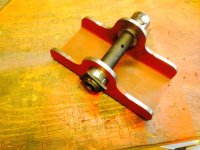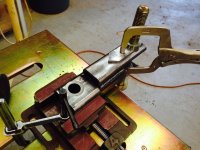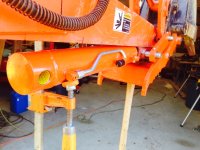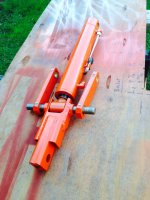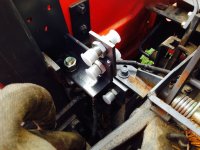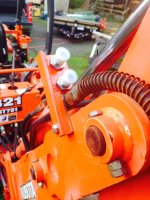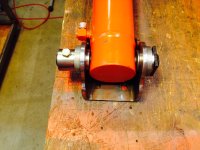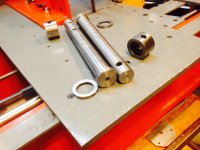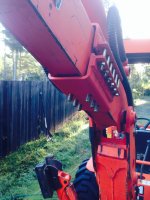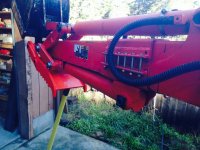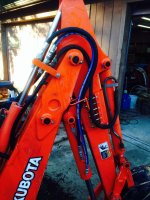Finally got the last of the mechanical parts assembled.
Photo 1. All along I have been planning to weld the cylinder base bracket to the bottom of the stick, using a doubler plate. But I've also had a nagging thought that the designers of this backhoe had no intent of a thumb operating force of any kind being applied to the bottom of the stick. And, the point where the bracket would have to be welded is also the point where the stick reinforcement plate ends. Welding a bottom bracket that bears 1/2 on the reinforced part of the stick, and 1/2 on the un-reinforced part, bothered me.
So instead, I decided to make a girdle out of 1/4" steel. It clamps on to the stick with twelve 5/16" bolts Grade 8. The girdle jams up tightly against the taper top and bottom, and has spacers welded inside that tighten against the sides of the stick as the bolts are tightened up. As a result the thumb operating force will be distributed somewhat, compared to being concentrated in one segment of the bottom of the stick.
The cylinder base bracket attaches to the girdle with six 1/2" bolts Grade 8.
Photo 2,3. The progressive linkage works exactly as planned. When closed it tucks tightly against the stick, and opens about 180 degrees. In most progressive linkages that I looked at, the links have to be curved to get clearance from the bucket boss when fully open. After considerable experimentation (in plywood, including some curved links) I decided on these straight 6.75" links. A shorter link would have interfered with the bucket boss when the thumb is open all the way. When the thumb is closed all the way, a longer link would have moved the hydraulic cylinder too far up the stick. This would cause interference with the boom when the stick is tucked in. Needless to say, the straight links were much easier to make than curved links would have been.
Photo 4,5. Testing the movement of the thumb hoses with the stick tucked in and then fully up. A retaining loop made from 1/4" rod keeps the hoses up close to the stick. Using the Kubota stabilizer cylinder, with fittings on the side, and a tubing loop to reverse direction of the bottom fitting, makes for a tight installation. Throughout this project I have had in mind to maintain the bulletproof
B21 design.
Photo 6. Now that I know the hoses are correct I will install the steel wire guard. The first task waiting is to demolish two ratty old sheds on the property, it will be a lot easier with the thumb.
The last remaining part of this project is to run the hoses and make the connections. No more fabrication. I am glad I went for the progressive linkage, but it is a lot more work than a straight cylinder-to-thumb linkage would have been.
